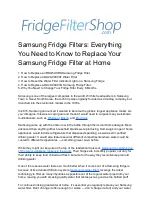
Service Manual
Green Bedding Separator eng_deu June 2012
Page 29 of 43
where a firm plug of solids is formed and is slowly
pushed out by the oncoming solids. If there are no solids
in the incoming liquid, then there is no movement in the
plug. The more uniform the concentration of the
incoming solids, the more uniform (”normal”) will be the
movement of the plug.
The uniformity of the inflow also controls the rate of
movement of the plug. For best operation, the incoming
slurry being pumped into the inlet T-pipe should be
homogenized with a mixer of sufficient capacity to keep
the solids in full suspension and uniform concentration.
The use of the by-pass pipe at the inlet T-pipe facilitates
uniform inflow into the Separator by by-passing the flow
above the volume that the Separator allows to go
through itself. The solids in the incoming fluid into the
Separator form a plug that cleans the screen. This self-
cleaning of the screen is the key to optimal operation of
the Separator.
The self-cleaning of the screen is seriously affected by
changes in the space tolerance between the auger and
the inner surface of the screen. Wear of the screen, or
of the outer edges of the flights of the auger from
abrasive solids or from long time operation, changes the
spacing configuration. This change in the spacing
configuration impacts the normal operation of the
Separator.
Symptoms of deviation from normal operation, probable
causes, and suggested remedies are provided at this
time to assist you with troubleshooting.
statt, d.h. das nicht am Feststoff über Kapillarwirkung
gebundene Wasser wird ausgebracht. Im so genannten
Pressbereich, in dem sich ein Pfropfen bildet, wird das
über Kapillarwirkung gebundene Wasser
herausgepresst. Befinden sich im Influent keine
Feststoffe, wird kein Pfropfen aufgebaut und es kommt
auch nicht zu einem Transport bzw. kontinuierlichen
Austrag des Pfropfens. Hierbei gilt grundsätzlich: je
höher und gleichmäßiger die Einlaufkonzentration an
Feststoffen ist, umso größer ist die
Austrittsgeschwindigkeit des Pfropfens aus dem
Presskopf.
Die Gleichmäßigkeit des Influents bestimmt direkt die
Austragsgeschwindigkeit des Pfropfens. Um eine
hinreichende Homogenisierung und Gleichmäßigkeit der
Feststoffe in der Flüssigkeit zu erzielen, ist der Einsatz
eines dem Durchsatz angepassten Rührwerkes im
Zulauftank erforderlich, bevor das Medium dem
Separator zugeführt wird. Die Verwendung einer
Bypass- bzw. Überlaufleitung am T-Stück des
Separatoreinlaufes verhilft dem Separator, nur die für
den Prozess optimale Menge, ohne Überdruck im
Separator zu erzeugen, abzunehmen. Der im Separator
gebildete Pfropfen bietet die Eigenschaft, dass es zu
einem Selbstreinigungsprozess für das Sieb und somit
immer zu einem optimalen Betrieb des Separators
kommt.
Dieser Selbstreinigungseffekt des Siebes wird
wesentlich durch den Arbeitsspalt zwischen Sieb und
Schnecke beeinflusst. Ein Verschleiß des Siebes oder
der Schnecke an den Aussenkanten der Flügel
verändert diesen Arbeitsspalt und beeinflusst damit
negativ den Selbstreinigungsprozess und damit den
„normalen“ Betrieb des Separators.
Erscheinungsbilder möglicher Abweichungen vom
„normalen Betriebszustand“ des Separators mit den
möglichen Ursachen und den Abhilfemaßnahmen sind
zu Ihrer Unterstützung im folgenden aufgeführt.
5.1.1
No Solids – No Liquids
If the Separator is running, but neither solids nor liquids
are coming out look for causes as follows:
Probable Cause(s)
Suggested Remedies
1.
Slurry Supply line is
interrupted:
Pump is out
Inlet T-pipe or vent
pipe is plugged;
siphoning is
occurring, [“full-pipe”
flow in bypass pipe];
the discharge end of
the bypass pipe is
submerged.
Blocked / clogged
effluent pipe
2.
The rotation of auger is
clockwise;
3.
Rotation pump is wrong;
pipes shake
4.
Stringy long hay clogs
flights blocks movement
of solids
1.
Check: Panel and Bypass
Pipe
Check controls
Restart pump
Clean Pipe [Fig. 2.4]
Install a larger
diameter vent pipe;
Slow down pumping
rate; ensure that the
discharge from the
bypass pipe is free.
Ensure free gravity
discharge
2.
Switch wire connections to
get counter-clockwise
rotation
3.
Change pump rotation
4.
Refurbish or replace
chopper knife in chopper
pump
5.1.1
Keine Feststoffe – Keine Flüssigkeiten
Wenn der Separator läuft, aber keine Feststoffe mehr
produziert werden und es tritt keine Flüssigkeit mehr
aus, sind die im folgenden aufgeführten Ursachen
möglich:
Mögliche Ursache(n)
Abhilfemaßnahme(n)
1.
Materialzufuhr ist
unterbrochen:
Pumpe ist aus
T-Stück am Einlauf
oder Entlüftung
verstopft; es tritt ein
Siphon-Effekt auf
[„Überlaufleitung ist
vollständig gefüllt“];
der Auslauf der
Überlaufleitung hängt
in der Flüssigkeit.
Verstopfte /
gedrosselte
Effluentleitung
2.
Die Schnecke läuft in
1.
Überprüfen Sie:
Schaltschrank und
Überlaufleitung.
Überprüfen und
starten Sie die
Pumpe
Säubern sie die
Leitungen [Abb. 2.4]
Installieren Sie ein
Entlüftungsrohr mit
größerem
Querschnitt;
Verringern Sie die
Pumpenkapazität;
Vergewissern Sie
sich, dass die
Überlaufleitung frei
ist.
Stellen Sie einen
freien Ablauf sicher.















































